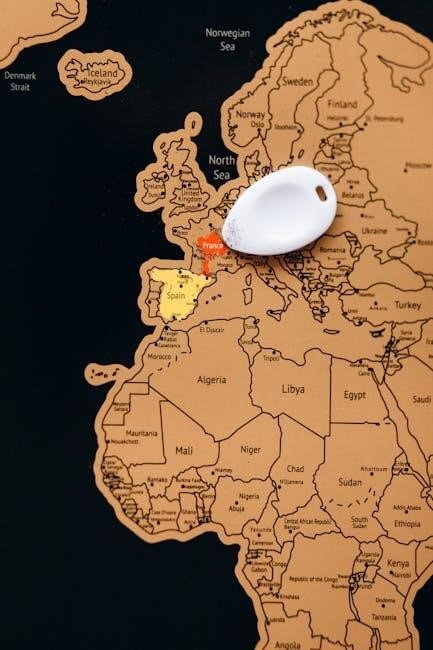A concept map is a visual tool that connects ideas, concepts, and information through arrows, images, and keywords, organizing knowledge in a structured, shareable PDF format.
What Are Concept Maps and Their Importance
A concept map is a visual representation of relationships between ideas, concepts, and information. It organizes knowledge in a structured, interconnected format, making complex data easier to understand. Their importance lies in their ability to enhance learning, brainstorming, and decision-making by providing a clear, visual framework. Concept maps are versatile tools used in education, project management, and research to simplify complex topics and foster collaboration. They are particularly effective for visual learners, offering a dynamic way to explore and communicate ideas.
Benefits of Using PDF for Concept Maps
PDF format is ideal for concept maps due to its universal compatibility and high-quality visual preservation. It ensures that concept maps remain unchanged across devices, maintaining their structure and design integrity. PDFs are easily shareable, printable, and accessible without requiring specialized software. They also support layers, annotations, and security features, making them a reliable choice for distributing and presenting concept maps professionally. This format is particularly useful for education, project management, and research, where clarity and consistency are essential.

Popular Tools for Creating Concept Maps
Miro, Canva, and Creately are leading tools for creating concept maps, offering intuitive design features, customizable templates, and collaboration options to visualize ideas effectively.
Miro: Features and Template Options
Miro offers robust features for creating concept maps, including a wide range of templates tailored to various projects. Its intuitive editing tools allow users to customize layouts, add icons, and collaborate in real-time. The platform supports seamless integration with other tools, enhancing productivity. Miro’s vast template library ensures users can find the perfect fit for their needs, making it a top choice for both professionals and educators.
Canva: Designing Visually Appealing Maps
Canva provides stunning concept map templates designed to captivate audiences. With a user-friendly interface, users can customize layouts, add vibrant colors, and incorporate visuals. Canva’s extensive library of fonts, icons, and images ensures maps are both informative and aesthetically pleasing. Its collaboration features make it ideal for teams, while the ability to export in PDF format guarantees professional-grade results for presentations, education, and project management needs.
Creately: Professional Concept Mapping
Creately offers professional-grade concept mapping tools with a wide range of customizable templates. Its intuitive interface simplifies brainstorming and organizing ideas, while real-time collaboration features make teamwork seamless. Offline access and version history ensure flexibility and control. Creately excels at transforming complex concepts into visually clear and structured maps, making it a top choice for professionals seeking precision and clarity in their PDF outputs.

Steps to Build a Concept Map from Scratch

- Identify the main idea or central concept to anchor your map.
- Add related concepts and branch them from the main idea.
- Link concepts using arrows or keywords to show relationships.
- Organize hierarchically, grouping ideas into categories.
- Finalize the design for clarity and visual appeal in PDF format.
Defining the Focus Question
Defining a clear focus question is the cornerstone of creating an effective concept map. This central question or idea guides the entire mapping process, ensuring all concepts and relationships stay relevant. For instance, when exploring “climate change,” the focus question might be, “What are the key causes and effects of climate change?” A well-defined question helps organize thoughts logically and provides a roadmap for building a structured and meaningful concept map in PDF format.
Adding Concepts and Relationships

After defining the focus question, the next step is to add concepts and relationships to your concept map. Start by brainstorming key ideas and sub-concepts related to the central question. Use tools like Miro or Canva to drag-and-drop concepts into the map. Connect these ideas with lines, arrows, or keywords to illustrate relationships. For example, in a climate change concept map, you might link “greenhouse gases” to “rising temperatures.” This step transforms abstract ideas into a visually organized framework, making complex information easier to understand and share in PDF format.
Organizing the Structure
Organizing the structure of your concept map is crucial for clarity. Start with a clear hierarchy, placing the main idea at the center. Use branching lines to connect related sub-concepts, ensuring a logical flow. Tools like Miro and Canva offer templates to help structure your map effectively. Arrange concepts in a way that visually represents their relationships, using colors and icons to differentiate categories. This step ensures your map is not only informative but also visually appealing when exported as a PDF.

Examples and Applications
Concept maps are versatile tools with applications in education, project management, and various fields. Examples include math problem-solving, biology processes, and marketing strategies, all easily shared in PDF format.
Educational Use Cases
Concept maps are widely used in education to enhance learning and teaching. Teachers use them to design curricula, plan lessons, and visualize complex topics. Students benefit by creating concept maps to organize knowledge, prepare for exams, and understand relationships between concepts. PDF formats make it easy to share and print these maps, ensuring accessibility for all learners. Subjects like biology, mathematics, and literature often utilize concept maps to break down information into digestible, visually engaging content.
Project Management Applications
Concept maps are invaluable in project management for visualizing workflows, tasks, and timelines. They help teams organize ideas, prioritize actions, and outline dependencies. PDF format allows easy sharing and collaboration, ensuring alignment among stakeholders. Tools like Miro and Canva offer templates to streamline the process, making it easier to create detailed project plans. By mapping out responsibilities and milestones, teams can track progress and ensure projects stay on schedule, enhancing overall efficiency and clarity in execution.
Other Fields of Application
Concept maps extend beyond education and project management, proving versatile in various industries. In marketing, they aid in outlining strategies and customer journeys. Healthcare professionals use them to visualize patient care plans and medical processes. Engineers and designers apply concept maps to brainstorm product ideas and system designs. Additionally, they are valuable in creative fields for storyboarding and in corporate settings for team collaboration. PDF format ensures these maps are easily shareable, making them a universal tool for organizing and visualizing complex ideas across disciplines.

Customization and Best Practices
Concept maps in PDF format can be customized with colors, icons, and fonts to enhance visual appeal. Ensure clarity by using legible fonts and logical hierarchies for better readability and organization.

Enhancing Visual Appeal
Enhancing the visual appeal of a concept map in PDF format involves using vibrant colors, icons, and images to make the information more engaging. Consistent font styles and sizes ensure readability, while spacing between elements prevents clutter. Adding legends or keys can improve comprehension. High-quality images and diagrams can further illustrate complex concepts, making the map both informative and aesthetically pleasing for users. These elements collectively create a professional and visually striking document.

Effective Use of Colors and Icons
Using a strategic combination of colors and icons in a concept map PDF enhances clarity and engagement. Assign colors to categorize concepts, making relationships visually distinct. Icons can represent abstract ideas, simplifying complex information. Consistency in color schemes and iconography ensures readability. High-contrast colors improve visibility, while subtle gradients or patterns can highlight key elements. Icons add visual interest, making the map more intuitive and easier to navigate. This visual hierarchy aids in understanding and retaining information effectively.
Ensuring Clarity and Readability
Clarity and readability are essential for effective concept maps in PDF format. Use clear, legible fonts and ensure proper spacing between elements. Avoid clutter by grouping related concepts and using visual hierarchies. Highlight key ideas with bold or larger text, and use arrows to indicate relationships clearly. Ensure the map is not overcrowded, allowing viewers to easily follow the flow of information. Regularly review and simplify the layout to maintain focus and ensure the content is logically organized and visually accessible.
Concept maps in PDF format are effective tools for visualizing ideas and organizing information. They offer versatility, clarity, and ease of sharing, making them invaluable for various applications.
Final Thoughts on Concept Maps
Concept maps are versatile tools that simplify complex information into visual frameworks. They aid in brainstorming, organizing ideas, and enhancing understanding across various fields. By providing a clear structure, they facilitate collaboration and creativity. Their universal appeal makes them indispensable for education, project management, and personal planning. Whether in PDF or digital formats, concept maps continue to empower individuals and teams to connect ideas and achieve clarity in their endeavors.
Future Trends and Tools

The future of concept mapping lies in advanced digital tools and AI integration, enhancing creativity and efficiency. Tools like Canva and Miro are evolving to offer more interactive and collaborative features. AI-driven suggestions for mapping relationships and auto-generating concepts are emerging trends. Additionally, customizable templates and real-time collaboration capabilities are expected to grow, making concept mapping more accessible and powerful for diverse applications. These advancements will continue to shape how we visualize and organize information in PDF and digital formats.